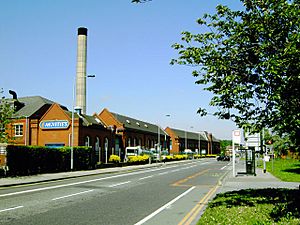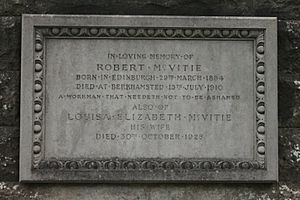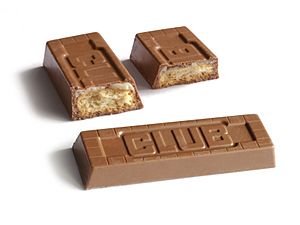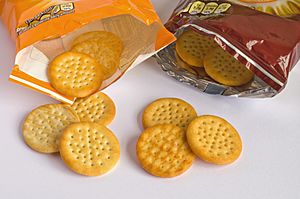McVitie's facts for kids

The McVitie's logo as updated in 2005
|
|
| Subsidiary | |
| Industry | Confectionery |
| Founded | 1830 Edinburgh, Scotland |
| Founder | Robert McVitie |
| Headquarters |
United Kingdom
|
|
Area served
|
UK, India, Italy, Canada, Australia, New Zealand, Ireland, the Netherlands, Israel, Egypt, Sweden, Turkey |
| Parent | Pladis |
McVitie's is a famous British snack food brand. It is owned by a company called Pladis. The brand started in 1830 in Edinburgh, Scotland. It was founded by a Scottish biscuit maker named Robert McVitie.
McVitie's is well-known for many popular biscuits and cakes. These include Jaffa Cakes, chocolate digestives, Hobnobs, and Rich tea biscuits. McVitie's has factories in the UK. The factory in Harlesden, London, makes the chocolate digestives. McVitie's is the best-selling biscuit maker in the United Kingdom. In 2020, their biscuit sales were much higher than their closest competitors.
Contents
History of McVitie's
How McVitie's Started
Robert McVitie was born in 1809. He learned how to be a baker. In 1830, he opened his first shop in Edinburgh, Scotland. He started at 130 Rose Street and later moved to 129 Rose Street.
By 1843, Robert had a second shop. His bakery grew over the years. In 1875, the company welcomed Charles Edward Price as a salesman. He was very successful.
Growing the Business
In 1888, Robert McVitie's son, also named Robert, was in charge of the business. He hired Alexander Grant, a skilled biscuit maker. Grant later became a very important person in the company.
In 1888, Robert McVitie's son and Charles Edward Price became partners. They created the company McVitie & Price. They built a huge factory in Edinburgh called the St Andrews Biscuit Works.
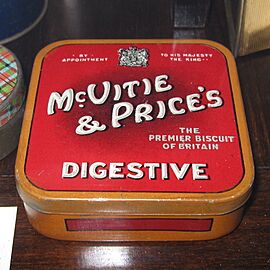
In 1891, the company changed its Rich Tea biscuit. They made it smaller to suit people in London. The original factory burned down in 1894. But it was quickly rebuilt even better. Production later moved to factories in England, like the one in Harlesden, London. This Harlesden factory, built in 1902, is now the largest biscuit factory in the UK.
After Robert McVitie's son passed away in 1910, Alexander Grant became the managing director. He was a major shareholder.
Joining Forces: United Biscuits

In 1948, McVitie & Price joined with another Scottish bakery company. They formed the United Biscuits Group. Today, McVitie's products are made in five factories across the United Kingdom. These include the original McVitie & Price factories in Harlesden, England and Stockport, England.
Famous Biscuits and Cakes
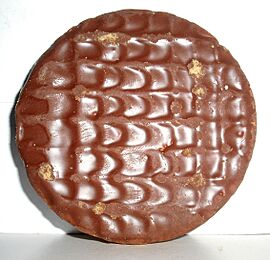
The first major biscuit from McVitie & Price was the digestive. It was created in 1892 by Alexander Grant. It was called "digestive" because people thought its ingredients helped with food digestion. Alexander Grant later became a very important leader in the company. He also helped fund the National Library of Scotland.
The McVitie's Chocolate Homewheat Digestive was first made in 1925. More than 71 million packets of McVitie's chocolate digestives are eaten in the UK every year. That's about 52 biscuits every second!
Hobnobs were launched in 1985. A chocolate version came out in 1987. Jaffa Cakes were launched in 1927. In 2012, they were the best-selling cake or biscuit in the UK.
Recent Times
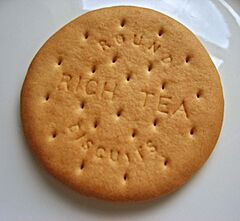
In 2009, McVitie's biscuits were voted the most popular for dunking in tea. Chocolate digestives, Rich tea, and Hobnobs were the top three favorites.
In 2014, United Biscuits, which owned McVitie's, was sold to a company from Turkey called Yildiz. In 2016, Yildiz combined some of its companies, including United Biscuits, to form Pladis.
In 2022, McVitie's closed its last factory in Scotland. This ended a long connection with the brand's Scottish beginnings. In the same year, McVitie's became a main sponsor for the TV show Britain's Got Talent. In 2023, McVitie's also sponsored the English football club Hull City.
Royal Wedding Cakes
McVitie's has a special history with royal weddings. In 1893, they made a wedding cake for the royal wedding of the Duke of York and Princess Mary. They later became King George V and Queen Mary. The cake was over 7 feet tall! It was seen by 14,000 people and brought great attention to the company. McVitie's received many requests for royal wedding and christening cakes after that.
In 1947, McVitie & Price made the main wedding cake for Princess Elizabeth (who became Queen Elizabeth II) and Philip Mountbatten. McVitie's was also asked to make a special chocolate biscuit cake for the 2011 wedding of Prince William and Catherine Middleton.
McVitie's Products
Biscuits
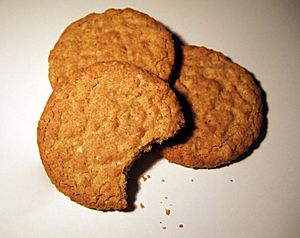
- Abbey Crunch
- All Butter Shortbread
- BN
- Chocolate Digestives
- Club Biscuits
- Cookies, including Boasters
- Deli Choc
- Digestives
- Digestives Lights
- Fig Roll
- Fruit shortcake
- Ginger Nuts
- Gold Bar
- Hobnobs
- Iced Gems
- Marie finger biscuit
- Minis
- Penguin
- Rich Tea
- Tasties
- Taxi
- Trio
- V.I.Bs (Very Important Biscuits)
Cakes

- Carrot Cake
- Fruit cake
- Jaffa Cakes
- Jamaica Ginger Cake
- Lemon Cake
- Lyle's Golden Syrup Cake
- Mini Rolls
- Moments Brownies
- Tunis Cake
- Waffles
Other Snacks
- Breakfast
- Cheddars
- Cracker Crisps
- Blissfills
- Digestive Thins
- Family Circle
- Krackawheats
- McVities Digestive Slices
- Minis
- Mini Cheddars
- Nibbles (Digestive and Hobnob varieties)
- Victoria Biscuit Selection
See also
 In Spanish: McVitie's para niños
In Spanish: McVitie's para niños
- Burton's Foods
- Fox's Biscuits
- Jacob Fruitfield Food Group
- Huntley & Palmers


